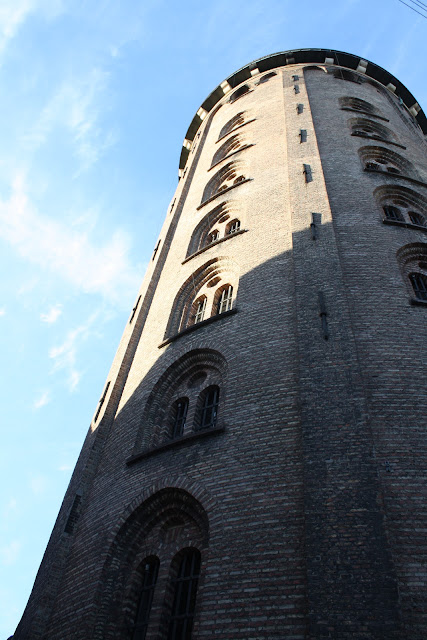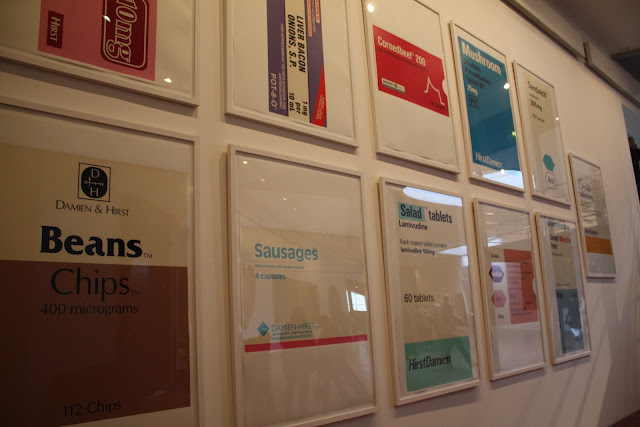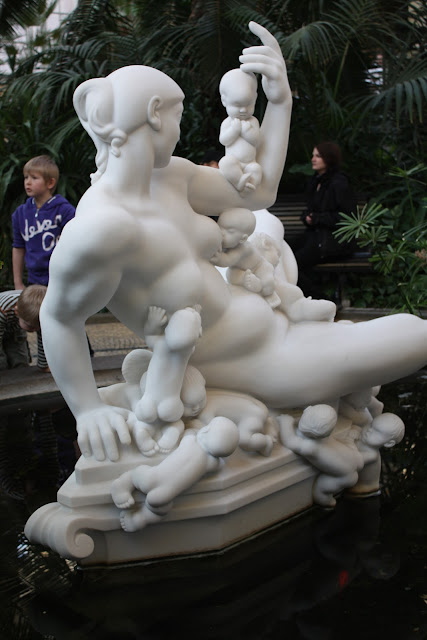Anyone who keeps the ability to see beauty, never grows old. - F. Kafka
Simple things can sometimes be the most beautiful. So fortunately, I have been able to capture some of the moments that I have found to be particularly lovely. Sunset over the frozen lake in Chrisitania, the weird and wonderful houses in that neighbourhood, fresh fallen snow flakes, hot air balloons, and then more recently the growths on potatoes I forgot about in my cupboard and a bumblebee that got stuck inside my apartment. I know. Whaaat? Being woken up by the sound of buzzing trying to escape out a window was a bit of a fright I have to admit but I had to take a photo before I let it go just because I'd never seen a bee so big and furry!
scandily clad.
Monday, April 11, 2011
frederikssund
Frederik is a fairly important name for Danish royals so as well as there being Frederiksborg Palace, Frederiksberg the municipality of Copenhagen where I live, and probably many others that I haven't come across yet, there is also Frederikssund. This is the destination we chose for the free train trip on the first Sunday of April (also my birthday for those playing at home.)
Also a quick bit of trivia: 'borg' means castle/palace, 'berg' or really 'bjerg' means mountain and apparently 'sund' means healthy. King Frederik the Healthy named Frederikssund? Hmm
Aaanyway, it was a small little town on the edge of the Roskilde Fjord with a strong Viking history. There wasn't much happening though because the main Viking 'games' and entertainments don't start until summer. So we mainly just had a casual stroll around the empty Viking village and checked out the fjord. And quite impressive it was too, especially because it wasn't a particularly nice day so there was a bit of fog across the water giving everything a nice eerie atmosphere.
Also a quick bit of trivia: 'borg' means castle/palace, 'berg' or really 'bjerg' means mountain and apparently 'sund' means healthy. King Frederik the Healthy named Frederikssund? Hmm
Aaanyway, it was a small little town on the edge of the Roskilde Fjord with a strong Viking history. There wasn't much happening though because the main Viking 'games' and entertainments don't start until summer. So we mainly just had a casual stroll around the empty Viking village and checked out the fjord. And quite impressive it was too, especially because it wasn't a particularly nice day so there was a bit of fog across the water giving everything a nice eerie atmosphere.
frederiksborg slot
The first Sunday of March (I know, a while ago now), I took the free S-train again with a couple of friends to the delightful town of Hillerød, north-west of Copenhagen. Here the main attraction is the Frederiksborg Castle and National History Museum. It was a glorious day and one of the first real days of sun since we had been in Denmark so the grounds were also a sight to see and would be absolutely marvellous in the summer for just relaxing by the water.
The palace used to be the royal residence until the death of Christian IV in 1648 and then was mainly used for official ceremonies like anointing and crowning the monarchs. Sometime later, I think in the 1850s, a fire destroyed part of the palace and after it was reconstructed, it then became the Museum of National History. The palace church is still used for its traditional purposes and apparently Prince Joachim even married his first wife there (that's Freddie's younger brother for those interested).
And of course, there were a couple of little things that tickled me enough to take a photo.
This guy won the competition for the most impressive moustache:
And this Thai Prince won the competition for the sassiest coat of arms. That's right gurlfren:
The palace used to be the royal residence until the death of Christian IV in 1648 and then was mainly used for official ceremonies like anointing and crowning the monarchs. Sometime later, I think in the 1850s, a fire destroyed part of the palace and after it was reconstructed, it then became the Museum of National History. The palace church is still used for its traditional purposes and apparently Prince Joachim even married his first wife there (that's Freddie's younger brother for those interested).
And of course, there were a couple of little things that tickled me enough to take a photo.
This guy won the competition for the most impressive moustache:
And this Thai Prince won the competition for the sassiest coat of arms. That's right gurlfren:
Friday, April 8, 2011
louisiana
Back on track. After a busy couple of months of uni and assessments I now have time to write more about what I've been doing in my spare time.
A couple of months ago now, one of the teachers from school took a group of us exchange students on a little excursion to the Louisiana Museum of Modern Art. Extremely generously, it was all paid for by the school including the train ride there and entrance as well. The main reason we went was to see the Picasso exhibition that had just opened the week before. It really was a great collection of paintings, sculptures, prints and drawings focusing on the artist's ability to interpret and transform the political and social events of the 20th century.
I wasn't able to take any photos of the exhibition but some of my favourite pieces were the posters that he had designed for various events as well as the sketches he had done for French newspapers.
The other parts of the museum were also excellent. The permanent collection had some really interesting things by some of the heavy weights of modern art including Warhol, Lichtenstein, Yves Klein and Alberto Giacometti. There was also a really great exhibition by American artist Walton Ford who does paintings of animals of all kinds in the style of old zoological illustrations. They were amazingly detailed and beautiful and grotesque at the same time. As an artist I hadn't heard of before, it was really great to be able to see such a collection of his work.
http://www.louisiana.dk/uk
A couple of months ago now, one of the teachers from school took a group of us exchange students on a little excursion to the Louisiana Museum of Modern Art. Extremely generously, it was all paid for by the school including the train ride there and entrance as well. The main reason we went was to see the Picasso exhibition that had just opened the week before. It really was a great collection of paintings, sculptures, prints and drawings focusing on the artist's ability to interpret and transform the political and social events of the 20th century.
I wasn't able to take any photos of the exhibition but some of my favourite pieces were the posters that he had designed for various events as well as the sketches he had done for French newspapers.
The other parts of the museum were also excellent. The permanent collection had some really interesting things by some of the heavy weights of modern art including Warhol, Lichtenstein, Yves Klein and Alberto Giacometti. There was also a really great exhibition by American artist Walton Ford who does paintings of animals of all kinds in the style of old zoological illustrations. They were amazingly detailed and beautiful and grotesque at the same time. As an artist I hadn't heard of before, it was really great to be able to see such a collection of his work.
http://www.louisiana.dk/uk
Monday, March 14, 2011
rundetårn
One of the things I would recommend for anyone who is visiting Copenhagen would be to take a look at the Rundetårn (The Round Tower). It's close to the centre of the city and serves as a great place to get a really nice view of the whole city.
The tower was completed in 1642 and was built to house three important facilities: an astronomical observatory, a church for students and a university library. They are all joined by way of a spiral ramp that winds up the inside of the tower. The official reason for this was to allow horse and cart access to the library to move books around but rumour has it that there used to be races between the King and Noblemen. Evidence of this is a couple of medals in a small gallery in the tower displaying things like "fastest time to the top of the tower". It's good to know the King was spending his time profitably.
The library these days plays host to various exhibitions of art, culture and history. When I visited, this space was used for an exhibition called "Hungry Planet". This was a display of photos of families from all over the world showing their weekly food expenditure. I thought it was really interesting to see comparisons of countries from developing and developed countries and also to see how people from two developed countries, like Denmark and the US, have different food philosophies and the different kinds of food products they spend more money on.
The tower was completed in 1642 and was built to house three important facilities: an astronomical observatory, a church for students and a university library. They are all joined by way of a spiral ramp that winds up the inside of the tower. The official reason for this was to allow horse and cart access to the library to move books around but rumour has it that there used to be races between the King and Noblemen. Evidence of this is a couple of medals in a small gallery in the tower displaying things like "fastest time to the top of the tower". It's good to know the King was spending his time profitably.
The library these days plays host to various exhibitions of art, culture and history. When I visited, this space was used for an exhibition called "Hungry Planet". This was a display of photos of families from all over the world showing their weekly food expenditure. I thought it was really interesting to see comparisons of countries from developing and developed countries and also to see how people from two developed countries, like Denmark and the US, have different food philosophies and the different kinds of food products they spend more money on.
Tuesday, February 22, 2011
ishøj and køge
On the first Sunday of every month the S-tog trains in Copenhagen are free! So on the first Sunday of February, a group of us exchange students organised to go to the Arken Museum of Modern Art in Ishøj and then if we had time, on to the end of the line and Køge.
It took about 20 minutes to get to our first stop and then we walked for about an hour to get to the museum from the train. Luckily it was a pretty nice day - a bit overcast but not really freezing - so this was tolerable. The Arken Museum was pretty amazing. The building itself was pretty impressive and it also was home to an interesting collection of Modern art installations.
The highlights for me were the Olafur Eliasson piece called Din Bline Passager (Your Blind Passanger) which was a long tunnel filled with smoke and coloured light making it almost impossible to see more than a metre in front of you. It really was a surreal experience. I wasn't too keen on it at the time, but I think the artist was somewhat successful in creating a space that challenges the concept of shared and personal space.
There is also a beach at Ishøj which was ok but not that nice - the weather was pretty crappy I'll admit, but it was quite small and quite close to an industrial area so the view wasn't that great either. We stopped here for only a couple of minutes before heading back to the station and onto Køge which was a pretty little seaside town. Apparently it was once know for witch-burning, but we weren't there long enough to see any evidence of that. We were also there late on a Sunday afternoon, so not much was open and there weren't that many people about. We did manage to find a kebab place and a pub that were open for some refreshments and to warm up before heading back to Copenhagen.
It took about 20 minutes to get to our first stop and then we walked for about an hour to get to the museum from the train. Luckily it was a pretty nice day - a bit overcast but not really freezing - so this was tolerable. The Arken Museum was pretty amazing. The building itself was pretty impressive and it also was home to an interesting collection of Modern art installations.
The highlights for me were the Olafur Eliasson piece called Din Bline Passager (Your Blind Passanger) which was a long tunnel filled with smoke and coloured light making it almost impossible to see more than a metre in front of you. It really was a surreal experience. I wasn't too keen on it at the time, but I think the artist was somewhat successful in creating a space that challenges the concept of shared and personal space.
Other highlights of the museum were a wall covered in photos of landscapes, some butterflies that represented social issues and some Damien Hirst pieces that were quite humorous - posters of food packagings made to look like prescription medicines.
There is also a beach at Ishøj which was ok but not that nice - the weather was pretty crappy I'll admit, but it was quite small and quite close to an industrial area so the view wasn't that great either. We stopped here for only a couple of minutes before heading back to the station and onto Køge which was a pretty little seaside town. Apparently it was once know for witch-burning, but we weren't there long enough to see any evidence of that. We were also there late on a Sunday afternoon, so not much was open and there weren't that many people about. We did manage to find a kebab place and a pub that were open for some refreshments and to warm up before heading back to Copenhagen.
ny carlsberg glyptotek
This museum was originally established to house the art collection of Carl Jacobsen who was the son of the founder of Carlsberg Breweries. It's primarily a sculpture museum (that's what 'glyptotek' means according to my friend Wikipedia) but has quite a bit of French Impressionist and Danish Golden-Age paintings.
There was a large collection of Rodin sculptures as well as some bronze sculptures by Degas which were very interesting. But the collections that interested me the most here were the Ancients - especially Egypt and Greece.
I've never really had much time for Egyptian art, I think because it's one of the first things you learn about in art classes at school at an age when it's just not cool to care about some old Pharaohs and what they were doing 3000 years ago. But here, I discovered a new-found appreciation for the way that the Egyptians worked and the influences it has had on Modern art and design. The attention to detail but spare decoration really resonates with the Modernist ideologies of form follows function and showing off materials to their greatest advantage.
The ancient Greek collection I also found to be quite entertaining and funny in parts. I think I may have only been so amused because I was still jet-lagged at the point in time and was by myself at the museum so I had to entertain myself somehow. But I found a young Greek boy with a monobrow:
and a collection of spare noses and ears:
There was a large collection of Rodin sculptures as well as some bronze sculptures by Degas which were very interesting. But the collections that interested me the most here were the Ancients - especially Egypt and Greece.
I've never really had much time for Egyptian art, I think because it's one of the first things you learn about in art classes at school at an age when it's just not cool to care about some old Pharaohs and what they were doing 3000 years ago. But here, I discovered a new-found appreciation for the way that the Egyptians worked and the influences it has had on Modern art and design. The attention to detail but spare decoration really resonates with the Modernist ideologies of form follows function and showing off materials to their greatest advantage.
The ancient Greek collection I also found to be quite entertaining and funny in parts. I think I may have only been so amused because I was still jet-lagged at the point in time and was by myself at the museum so I had to entertain myself somehow. But I found a young Greek boy with a monobrow:
and a collection of spare noses and ears:
The foyer of the museum itself is quite spectacular with an indoor garden and apparently a very good and reputable restaurant serving traditional Danish cuisine. I didn't eat here because unfortunately it was a bit pricey for my student budget, but it did smell pretty good. There was also a pretty weird statue in the garden that didn't seem to have any relationship to anything else in the museum, and no explanation as to who did it or what it was all about.
Subscribe to:
Comments (Atom)







































